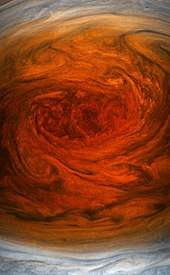JEDI


JEDI (Jupiter Energetic-particle Detector Instrument[1]), is an instrument on the Juno spacecraft orbiting planet Jupiter.[2] It is part of a suite of instruments to study the magnetosphere of Jupiter.[2] JEDI consists of three identical detectors that use microchannel plates and foil layers to detect the energy, angle, and types of ion within a certain range.[3] It can detect electrons between 40 and 500 keV (Kilo electron-volts), and hydrogen and oxygen from a few tens of keV to less than 1000 keV (1 MeV).[3] JEDI uses radiation hardened Application Specific Integrated Circuits (ASIC)s.[4] JEDI was turned on in January 2016 while still en route to Jupiter to also study interplanetary space.[5]
JEDI is designed to collect data on "energy, spectra, mass species (H, He, O, S), and angular distributions";[2] the plan is to study the energies and distribution of charged particles.[6] It can detect them at between 30 keV and 1 GeV, whereas JADE, another instrument on the spacecraft, is designed to observe below 30 keV.[7] One of the concepts being studied is that energy from Jupiter's rotation is being converted into its atmosphere and magnetosphere.[7]
It is radiation hardened to collect in situ data on the planet's auroral magnetic field lines, the equatorial magnetosphere, and the polar ionosphere [2] It was built by the Johns Hopkins University Applied Physics Laboratory (APL).[8] One of the goals is to understand the aurora, and how particles are accelerated to such high speeds.[9] One of the mysteries of Jupiter is that X-rays are emitted from the poles, but do not seem to come from the auroral ring.[10]
Each detector has a field of view of 120 degree by 12 degrees, and they are positioned to provide a 360 degree (a full circle) view of the sky along that axis.[11]
JEDI can detected particles from 30 to 1000 keV including:[12]
- Electrons
- Proton (hydrogen) ions
- Helium ions
- Sulfur ions
- Oxygen ions
- Energetic neutral atoms
In relation to other space missions, an instrument on the Earth-orbiting Van Allen Probes (launched 2012), called RBSPICE, is nearly identical to JEDI.[13] This type of instrument is also similar to the PEPSSI instrument on New Horizons (Pluto/Kupiter probe).[13]
See also
- JunoCam (Visible-light camera on Juno orbiter)
- Jovian Auroral Distributions Experiment (JADE)
- Jovian Infrared Auroral Mapper (JIRAM)
- Magnetometer (Juno) (MAG)
- UVS (Juno)
- Microwave Radiometer (Juno)
- Waves (Juno) (Radio and Plasma wave instrument)
- Gravity Science
References
- ↑ Official NASA Juno Instruments and Spacecraft diagram
- 1 2 3 4 D. K. Haggerty; B. H. Mauk; C. P. Paranicas (December 2008). "JEDI -- The Jupiter Energetic Particle Detector for the Juno mission". Bibcode:2008AGUFMSM41B1683H.
- 1 2
- ↑ Garner, Rob (2016-07-12). "Tiny Microchips Enable Extreme Science at Jupiter". NASA. Retrieved 2017-01-06.
- ↑ NASA’s Juno and JEDI: Ready to Unlock Mysteries of Jupiter - June 2016
- ↑ W. Grahm (2011). "ULA Atlas V launches NASA’s Juno on a path to Jupiter" (Press release). Nasaspaceflight.com.
- 1 2 NASA - Video on JEDI
- ↑ "Space scientists seek returns from JEDI" (Press release). Johns Hopkins University Applied Physics Laboratory. 5 August 2011.
- ↑ P. Gilster. "Juno: into the Jovian magnetosphere". Centari Dreams.
- ↑ "Puzzling X-rays from Jupiter" (Press release). NASA. 7 March 2002.
- ↑ NASA’s Juno and JEDI: Ready to Unlock Mysteries of Jupiter June 2016
- ↑ NASA’s Juno and JEDI: Ready to Unlock Mysteries of Jupiter - June 2016
- 1 2 The Van Allen Probes Mission edited by Nicola Fox, James L. Burch


